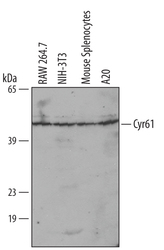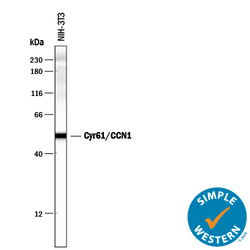Antibody data
- Antibody Data
- Antigen structure
- References [3]
- Comments [0]
- Validations
- Western blot [2]
- Immunohistochemistry [1]
Submit
Validation data
Reference
Comment
Report error
- Product number
- AF4055 - Provider product page

- Provider
- R&D Systems
- Product name
- Mouse Cyr61/CCN1 Antibody
- Antibody type
- Polyclonal
- Description
- Antigen Affinity-purified. Detects mouse Cyr61/CCN1 in direct ELISAs and Western blots. In direct ELISAs, this antibody shows approximately 10% cross-reactivity with recombinant human Cyr61/CCN1.
- Reactivity
- Mouse
- Host
- Sheep
- Conjugate
- Unconjugated
- Antigen sequence
NP_034646- Isotype
- IgG
- Vial size
- 100 ug
- Concentration
- LYOPH
- Storage
- Use a manual defrost freezer and avoid repeated freeze-thaw cycles. 12 months from date of receipt, -20 to -70 °C as supplied. 1 month, 2 to 8 °C under sterile conditions after reconstitution. 6 months, -20 to -70 °C under sterile conditions after reconstitution.
Submitted references CCN1/CYR61-mediated meticulous patrolling by Ly6Clow monocytes fuels vascular inflammation.
CCN1 induces hepatic ductular reaction through integrin αvβ₅-mediated activation of NF-κB.
Matricellular protein CCN1 promotes regression of liver fibrosis through induction of cellular senescence in hepatic myofibroblasts.
Imhof BA, Jemelin S, Ballet R, Vesin C, Schapira M, Karaca M, Emre Y
Proceedings of the National Academy of Sciences of the United States of America 2016 Aug 16;113(33):E4847-56
Proceedings of the National Academy of Sciences of the United States of America 2016 Aug 16;113(33):E4847-56
CCN1 induces hepatic ductular reaction through integrin αvβ₅-mediated activation of NF-κB.
Kim KH, Chen CC, Alpini G, Lau LF
The Journal of clinical investigation 2015 May;125(5):1886-900
The Journal of clinical investigation 2015 May;125(5):1886-900
Matricellular protein CCN1 promotes regression of liver fibrosis through induction of cellular senescence in hepatic myofibroblasts.
Kim KH, Chen CC, Monzon RI, Lau LF
Molecular and cellular biology 2013 May;33(10):2078-90
Molecular and cellular biology 2013 May;33(10):2078-90
No comments: Submit comment
Supportive validation
- Submitted by
- R&D Systems (provider)
- Main image

- Experimental details
- Detection of Mouse Cyr61/CCN1 by Western Blot. Western blot shows lysates of mouse spleenocyte cell, RAW 264.7 mouse monocyte/macrophage cell line, NIH-3T3 mouse embryonic fibroblast cell line, and A20 mouse B cell lymphoma cell line. PVDF membrane was probed with 1 µg/mL of Mouse Cyr61/CCN1 Antigen Affinity-purified Polyclonal Antibody (Catalog # AF4055) followed by HRP-conjugated Anti-Sheep IgG Secondary Antibody (Catalog # HAF016). A specific band was detected for Cyr61/CCN1 at approximately 50 kDa (as indicated). This experiment was conducted under reducing conditions and using Immunoblot Buffer Group 1.
- Submitted by
- R&D Systems (provider)
- Main image

- Experimental details
- Detection of Mouse Cyr61/CCN1 by Simple WesternTM. Simple Western lane view shows lysates of NIH-3T3 mouse embryonic fibroblast cell line, loaded at 0.2 mg/mL. A specific band was detected for Cyr61/CCN1 at approximately 51 kDa (as indicated) using 10 µg/mL of Sheep Anti-Mouse Cyr61/CCN1 Antigen Affinity-purified Polyclonal Antibody (Catalog # AF4055) followed by 1:50 dilution of HRP-conjugated Anti-Sheep IgG Secondary Antibody (Catalog # HAF016). This experiment was conducted under reducing conditions and using the 12-230 kDa separation system.
Supportive validation
- Submitted by
- R&D Systems (provider)
- Main image

- Experimental details
- Cyr61/CCN1 in Mouse Embryo. Cyr61/CCN1 was detected in immersion fixed frozen sections of mouse embryo (13 d.p.c.) using 15 µg/mL Mouse Cyr61/CCN1 Antigen Affinity-purified Polyclonal Antibody (Catalog # AF4055) overnight at 4 °C. Tissue was stained with the Anti-Sheep HRP-DAB Cell & Tissue Staining Kit (brown; Catalog # CTS019) and counterstained with hematoxylin (blue). Specific labeling was localized to the cytoplasm of muscle cells. View our protocol for Chromogenic IHC Staining of Frozen Tissue Sections.
 Explore
Explore Validate
Validate Learn
Learn Western blot
Western blot